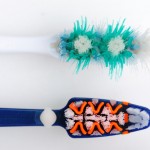
Effective toothbrushing is important for maintaining and improving oral health. Regular daily brushing using a good brushing technique helps prevent gingivitis. Since the introduction of nylon filaments in the 1930 there has been much variation in toothbrush design with variations in the number, arrangement and length of filaments in a tuft. After the American Dental Association (ADA) recommended that tufts be “free of sharp or jagged edges and endpoints” to minimize gingival and dental abrasions most manual brushes have conical or end-rounded laments.
The aim of this review was to compare the effect of manual toothbrush with tapered filaments to one with end-rounded filaments on the clinical parameters of plaque, gingivitis and gingival abrasions.
Methods
Searches were conducted in the Medline and the Cochrane Central Register of Controlled Trials (CENTRAL) and the manufacturer of the Meridol toothbrush (GABA/Colgate in Switzerland) was contacted for unpublished data. English language randomised controlled trials (RCTs) comparing tapered lament toothbrushes (TFTB) with end-rounded toothbrushes (ERTB) evaluating Plaque index(PI) (bleeding scores (BS), gingivitis index (GI)) or gingival abrasion (GA) were considered.
Two reviewers independently selected studies abstracted data and assessed study quality and the Grading of Recommendations Assessment, Development and Evaluation system was used for overall assessment. The primary variable of interest was PI. Descriptive analysis and a meta-analysis were performed when appropriate.
Results
- 7 RCTs were included
- All studies excluded patients with periodontitis
- Evaluation period ranged from single use to 6 months.
- All except 1 were funded by GABA International, now part of Colgate Palmolive.
- Meta-analysis for
- PI scores – did not show a significant difference between TFTB and ERTB, mean difference = 0.10 (95% CI; −0.13 to 0.32) [ Low GRADE evidence]
- GI scores – showed a significant mean difference in favour of the TFTB, mean difference = – 0.12 (95% CI; -0.17 to – 0.07). [medium GRADE evidence]
- No differences were found in 3 comparisons evaluating gingival abrasion.
Conclusions
The authors concluded
With respect to plaque removal, evidence was not conclusive to recommend the TFTB over an ERTB. Regarding GI, a small effect in favour of a TFTB was noted, the clinical relevance of this difference is probably negligible. Therefore, based on the collective evidence emerging from this systematic review, the strength and direction of the recommendation there appears to be no firm evidence for a dental healthcare professional to advise the use of a TFTB over the use of an ERTB.
Comments
While this review followed a standard process limiting to English language studies could have missed eligible studies. The authors also highlight a number of limitation with the included studies. The toothbrushes used has a range of different characteristics including different filament angle and additional cleaning tips and rubber cups. Brushing duration was not standardised and all but one study was supported by the same manufacturer. Although little difference was seen between the two types of brushes the quality of the evidence was limited.
The authors recommended that future toothbrushing studies should follow the recently update ADA guideline for the design and conduct of clinical studies for manual toothbrushes. In this review only one of the included studies complied with the ADA guidance.
Links
Primary paper
Hoogteijling F, Hennequin-Hoenderdos NL, Van der Weijden GA, Slot DE. The effect of tapered toothbrush filaments compared to end-rounded filaments on dental plaque, gingivitis and gingival abrasion: a systematic review and meta-analysis. Int J Dent Hyg. 2017 Feb 7. doi: 10.1111/idh.12272. [Epub ahead of print] Review. PubMed PMID: 28173609.
Other references
Dental Elf – 27th Jun 2016
Dental Elf – 11th Aug 2014

[…] post Toothbrushes: are tapered or end-rounded filaments best? appeared first on National Elf […]